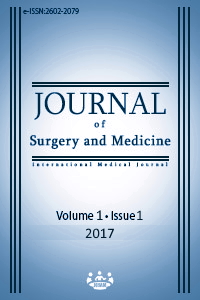Risk Assessments, Pregnancy and Birth Processes of Pregnant Women at Primary Health Care Center: A Retrospective Study
Keywords:
Risk, Pregnancy, Early birthAbstract
Aim: Although many pregnancies and birth processes have passed without any problems, all pregnancies have various risks. The main purpose should be to control risky situations in pregnancy without threatening the health of mother and baby. Our study was carried out in order to investigate the complications related to the risks determined by the risk assessments of women who were followed during pregnancy and puerperants in a family health center.
Methods: Women who were registered in the family medicine unit and whose pregnancy and puerperium were followed were scanned through the automation system during the study period. During the pregnancy periods, risk factors and time of birth were examined. Patients with any risk factor were considered as risky pregnant and examined whether a pathological condition developed during pregnancy or during the postpartum period.
Results: It was determined that during pregnancy period 10 pregnant women had at least one risk factor of 81 pregnant women whose risk assessments were examined. The distribution of risk factors was as follow; 3 with grand-multiparity story, 3 with preterm delivery, 2 with pregnancy over 35, 2 with Rh incompatibility, 1 with cardiovascular disease, 1 with multiple pregnancy, 1 with preterm labor, and under 18 years of age in 1 pregnant women was determined. It was found statistically significant that the risk of having a risk factor was higher than that of non-risk patients at 38 weeks (p<0.01). Among the risk factors, when the patients with preterm delivery and preterm delivery were excluded, it was also found that the preterm delivery risk increased significantly (p=0.012).
Conclusions: In pregnancies with risk factors, complications may occur much more than normal pregnancies. Therefore, it is very important for women to communicate with family physicians while planning pregnancy, if their risks are identified and appropriate approach protocols are used to ensure that both the mother and baby survive and maintain a healthy life.
Downloads
References
Gebelik ve Doğumda Komplikasyonların Yönetimi. Üreme Sağlığı ve Araştırma Departmanı Aile ve Toplum Sağlığı Dünya Sağlık Örgütü. ISBN: 92 4 154587 9 Geneva – 2003. ss: vii.
Altıparmak S. Türkiye’de Ana Sağlığı Düzeyi http://halksagligi.med.ege.edu.tr/seminerler/2006-07/Ana_sagligi_SA.pdf ss: 5-7. Erişim tarihi: 30.08.2017.
Riskli Gebelikler Yönetim Rehberi T.C. Sağlık Bakanlığı Türkiye Halk Sağlığı Kurumu Kadın ve Üreme Sağlığı Daire Başkanlığı, Yayın No:926 Ankara, 2014.
Taşkın L. Doğum ve Kadın Sağlığı Hemşireliği.10. Baskı. ISBN: 975-94661-0-4 Ankara- 2011. ss: 227-273.
Qeenan JT, Hobbins JC. Yüksek Riskli Gebeliklerde Tanı ve Tedavi Protokolleri. Güner H (ed.)3. Baskı. ISBN: 975-7175-06-04 Ankara - 1998.ss: 3-8.
KURU A. Yüksek Lisans Tezi; “Gebelerin Risk Durumunun Belirlenmesinde Kullanılan “Knox Skorlama Sisteminin Geçerliliğinin Değerlendirilmesi” Ege Üniversitesi Sağlık Bilimleri Enstitüsü Ebelik Anabilim Dalı, Tez Yöneticisi; Yrd. Doç. Dr. Neriman Soğukpınar. İzmir - 2007.
Queenan JT, Spong CY, Lockwood CJ. Overview Of High-Risk Pregnancy, Queenan JT (ed.), Spong CY (ed.), Lockwood CJ (ed.). Management of High-Risk Pregnancy. 5. Edition. ISBN-13: 978-1-4051-2782-0 UK - 2007: ss: 16-17.
Maternal-Fetal Tıp ve Perinatoloji Derneği. Tanı ve Tedavi Klavuzları. Öncü Basımevi. 2005.
Kavuncuoğlu S, Öztürk E, Alyıldız ES, Ceylan Y, Özbek S. Riskli gebelik nedeni ile izlenen annelerden doğan preterm bebeklerin erken dönem morbidite ve mortalite sonuçları. JOPP Derg 2010; 2(1):27-30
Lee S, AyersS, Holden D. Risk perception of women during high risk pregnancy: A systematic review. Health, Risk &Society 2012;14(6):511–531.
Doğum Öncesi Bakım Yönetim Rehberi. T.C. Sağlık Bakanlığı Ana Çocuk Sağlığı ve Aile Planlaması Genel Müdürlüğü. Ankara - 2009. ss: 9-41.
Hancıoğlu A. Bebek ve Çocuk Ölümlülüğü, Türkiye Nüfus ve Sağlık Araştırması 1998. Hacettepe Üniversitesi Nüfus Etütleri Enstitüsü. Ankara – 1999. ss: 97-104.
Hancıoğlu A, Alyanak İY. Bebek ve Çocuk Ölümlülüğü, Türkiye Nüfus ve Sağlık Araştırması 2003. Hacettepe Üniversitesi Nüfus Etütleri Enstitüsü. Ankara – 2004. ss: 109-118.
Yiğit Kurtuluş E, Tezcan S, Tunçkanat H. Çocuk Sağlığı, Türkiye Nüfus ve Sağlık Araştırması 2008. Hacettepe Üniversitesi Nüfus Etütleri Enstitüsü. ISBN: 978-975-491- 274-6 Ankara - 2008.ss:139-141.
Garcia H, Avendano NP, Islas-Rodriguez. Neonatal and maternal morbidity among adolescent and adult women. A comparative study. Rev Invest Clin 2008; 60(2):94-100.
Moster D, Lie RT, Merkestad T. Long-term medical and social con- sequences of preterm birth. N Engl J Med 2008; 359(3):262-73.
Slattery MM, Geary M, Morrison JJ. Obstetric antecedents for pre- term delivery. J Perinat Med 2008; 36(4):306-9.
Goldenberg RL, et al. Intrauterine infection and preterm delivery. N Engl J Med 2000; 342: 1500.
Altuncu E, Kavuncuoğlu S, Albayrak Z, et al: The effect of premature rupture of membranes to the morbidity and mortality of preterm babies. Zeynep Kamil Tıp Bülteni 2005; 36:179-81
National High Blood Pressure Education Program Working Group: Report on high blood pressureduring pregnancy. Am J Obstet Gynecol 1990; 163:1689.
Drury MI, et al. Pregnancy in the diabetic patient: Timing and mode of delivery. Obstet Gynecol 1983; 62:279.
Shea MA, et al. Diabetes in pregnancy. Am J Obstet Gynecol 1971; 111:801. 20. Landon MB, Gabbe SG. Diabetes mellitus and pregnancy. Obstet Gynecol Clin North Am 1992; 19:633.
De Franco E, Atkins K. Preterm Labor, premature rupture of memb- ranes and cervical ınsufficiency. In: Evans AT, Niswander KR (eds). Manual of Obstetrics. Seventh ed. Lippincott Williams& Wilkins, 2000; 135-50.
Roger A. ve arkadaşları, Interspecialty Differences in the Obstetric Care of Low-Risk Women, American Journal of Public Health, March 1997, Vol. 87, No. 3 ss:344-351.
Gebeli̇kte Ri̇sk Değerlendi̇rme Formu , Gaziantep Halk Sağlığı Müdürlüğü www.ghs.gov.tr/Content/Upload/Birim/Dosyalar/RiskDegerlendirme.pdf Erişim Tarihi:31/08/2017.
Downloads
- 3519 3531
Published
Issue
Section
How to Cite
License
Copyright (c) 2017 Yıldız Atadağ, Abdülkadir Aydın, Didem Kaya, Ahmet Öksüz, Hatice Dilber Köşker
This work is licensed under a Creative Commons Attribution-NonCommercial-NoDerivatives 4.0 International License.















